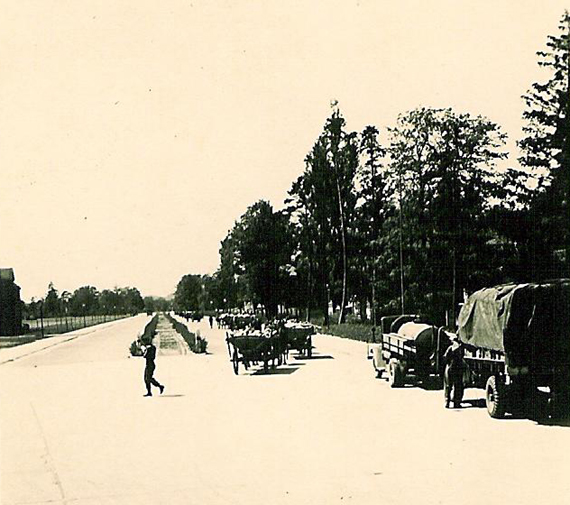Burial of the bodies after Dachau liberation

Dachau camp after it
was liberated
The old photos on this page were contributed
by Fred Ludwikowski, who got them from Robert Thomas Gray, a
soldier with the 14th Ordnance Co.
After Dachau was liberated, the camp
was turned into a prison for German soldiers. More barracks were
constructed and the capacity of the camp was increased to 30,000
prisoners. In the photo above, it appears that there is some
construction going on and there is what looks like a wagon load
of corpses. The Dachau inmates continued to die of typhus for
weeks after the camp was liberated.
Burial of the bodies at Dachau began
on May 13, 1945, more than two weeks after the camp was liberated.
The bodies had been left out so that as many American soldiers
as possible could be brought to Dachau to see the horror.

Dachau farmers haul
dead bodies from the camp
A sign on the gate in the photo above
warns that the camp is off limits because of a typhus epidemic
that has still not been brought under control. The buildings
in the background are in the SS garrison which was right next
to the Dachau prison camp. Note the team of perfectly matched
horses in the background.

Parade of wagons travels
along the Avenue of the SS

US Army trucks follow
the parade of wagons
Local farmers were forced to haul the
corpses to the Leitenberg, a hill near the camp, where they were
buried in mass graves, even though their names were known. The
farmers had to dress in their best Sunday clothes and the wagons
had to take a circuitous route through the town of Dachau. Note
that the US Army had plenty of trucks and personnel for this
task, but it was important to humiliate the locals and make them
feel guilty.

Mass graves on the
Leitenberg, May 2001
Dachau
citizens brought to Camp
Dachau
residents forced to bring food
Typhus epidemic
at Dachau
Old
photos taken after the liberation
Previous
Back to Dachau
Liberation
Back to Table
of Contents
Home
Burial of the bodies after Dachau liberationThe old photos on this page were contributed by Fred Ludwikowski, who got them from Robert Thomas Gray, a soldier with the 14th Ordnance Co. After Dachau was liberated, the camp was turned into a prison for German soldiers. More barracks were constructed and the capacity of the camp was increased to 30,000 prisoners. In the photo above, it appears that there is some construction going on and there is what looks like a wagon load of corpses. The Dachau inmates continued to die of typhus for weeks after the camp was liberated. Burial of the bodies at Dachau began on May 13, 1945, more than two weeks after the camp was liberated. The bodies had been left out so that as many American soldiers as possible could be brought to Dachau to see the horror. A sign on the gate in the photo above warns that the camp is off limits because of a typhus epidemic that has still not been brought under control. The buildings in the background are in the SS garrison which was right next to the Dachau prison camp. Note the team of perfectly matched horses in the background. Local farmers were forced to haul the corpses to the Leitenberg, a hill near the camp, where they were buried in mass graves, even though their names were known. The farmers had to dress in their best Sunday clothes and the wagons had to take a circuitous route through the town of Dachau. Note that the US Army had plenty of trucks and personnel for this task, but it was important to humiliate the locals and make them feel guilty.  Dachau citizens brought to CampDachau residents forced to bring foodTyphus epidemic at DachauOld photos taken after the liberationPreviousBack to Dachau LiberationBack to Table of ContentsHome |